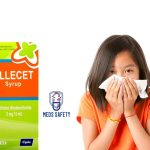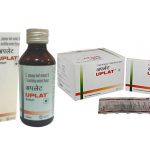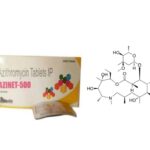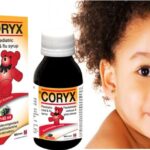Hyospasmol Tablets & Syrup: Uses, How it Works, Dosage, Side Effects

Hyospasmol is a South African brand of hyoscine butylbromide (Buscopan) produced by Aspen. Hyoscine belongs to the group of medications called antispasmodics. Hyoscine is used to relieve smooth muscle spasms (cramps) in the stomach and intestines and in the bladder and urethra.
Hyospasmol reduces spasms by relaxing smooth muscles within the stomach, intestines, bladder and urethra.
Each sugar-coated tablet contains 10 mg hyoscine butylbromide.
Each 5 ml contains 5 mg hyoscine-N-butylbromide.
What is Hyospasmol used for?
Hyospasmol is used to relieve painful stomach cramps, including those linked with irritable bowel syndrome (IBS). It can also help bladder cramps and period pain
Who should NOT take Hyospasmol?
Do not use this medication if you:
• are allergic to hyoscine or any ingredients of this medication
• are allergic to other atropinics (e.g., atropine, scopolamine)
• have myasthenia gravis
• have megacolon (enlarged colon)
• have glaucoma
• have obstructive prostatic hypertrophy (enlarged or blocked prostate)
In addition, do not use the injection form of this medication if you:
• are receiving this medication as an intramuscular injection and are taking a blood thinner medication (e.g., warfarin, heparin)
• have narrowing of the gastrointestinal tract
• have a fast heartbeat
• have angina
• have heart failure.

How to take Hyospasmol
The usual dose of Hyospasmol for stomach cramps (or cramping pain) in adults and children aged 12 years and over is 2 tablets taken 4 times a day.
For children aged 6 to 11 years, the usual dose is 1 tablet taken 3 times a day.
The usual dose of Hyospasmol for symptoms of IBS diagnosed by a doctor in adults and children aged 12 years and over is 1 tablet taken 3 times a day. You can increase this to 2 tablets taken 4 times a day if needed.
Hyospasmol syrup is used in the treatment of conditions associated with abdominal spasm (‘cramps’). Hyospasmol Syrup is suitable for use in infants as young as 1 month of age. However, Hyospasmol is not recommended to treat IBS in children under 12 years.
When to take Hyospasmol
Take Hyospasmol tablets as and when you have stomach cramps or period pain. Hyospasmol does not usually upset your stomach, so you can take it with or without food.
What if I forget to take it?
If you forget to take a dose, take it as soon as you remember. If you do not remember until it’s nearly time for the next dose, skip the missed dose. Never take 2 doses at the same time. Never take an extra dose to make up for a forgotten one. If you often forget doses, it may help to set an alarm to remind you.
You could also ask your pharmacist for advice on other ways that are suitable for you and your medicines.
What if I take too much?
If you take an extra dose of Hyospasmol, it’s unlikely to harm you. Speak to your pharmacist or doctor if you’re worried, or if you have taken more than 1 extra dose.
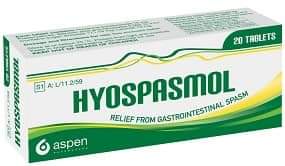
What are the side effects of Hyospasmol?
Many medications can cause side effects. A side effect is an unwanted response to a medication when it is taken in normal doses. Side effects can be mild or severe, temporary or permanent.
The side effects listed below are not experienced by everyone who uses this medication. If you are concerned about side effects, discuss the risks and benefits of this medication with your doctor.
The following side effects have been reported by at least 1% of people using this medication. Many of these side effects can be managed, and some may go away on their own over time.
Contact your doctor if you experience these side effects and they are severe or bothersome. Your pharmacist may be able to advise you on managing side effects.
• blurred vision that is temporary
• constipation
• decreased ability to sweat
• diarrhea
• dizziness
• dry mouth
• fast heartbeat
• flushing
• nausea
Although most of the side effects listed below don’t happen very often, they could lead to serious problems if you do not seek medical attention.
Check with your doctor as soon as possible if any of the following side effects occur:
• difficulty urinating
• dizziness or lightheadedness when getting up from a lying or sitting position
• shortness of breath
• skin rash and itching
• vision changes
Stop using the medication and seek immediate medical attention if any of the following occur:
• painful red eye with loss of vision
• symptoms of a severe allergic reaction (e.g., hives; difficulty breathing; swelling of the face, mouth, tongue, or throat)
Some people may experience side effects other than those listed. Check with your doctor if you notice any symptom that worries you while you are using this medication.
Are there any other precautions or warnings for this medication?
Before you begin using a medication, be sure to inform your doctor of any medical conditions or allergies you may have, any medications you are taking, whether you are pregnant or breast-feeding, and any other significant facts about your health. These factors may affect how you should use this medication:
Difficulty urinating: Hyospasmol may make it more difficult for you to urinate. If you have an enlarged prostate, urinary retention, or difficulty urinating, discuss with your doctor how this medication may affect your medical condition, how your medical condition may affect the dosing and effectiveness of this medication, and whether any special monitoring is needed.
Fructose intolerance: Fructose intolerance is a rare condition in which fructose (a type of sugar) is not broken down by the body. One sugar-coated tablet of 10 mg contains 41.2 mg of sucrose, which can result in 411.8 mg of sucrose per day if the maximum recommended daily dose of hyoscine is needed. You should not use this medication if you have fructose intolerance.
Glaucoma: Hyospasmol may cause the symptoms of glaucoma (increased pressure in the eye) to develop or become worse. If you have glaucoma, discuss with your doctor how this medication may affect your medical condition, how your medical condition may affect the dosing and effectiveness of this medication, and whether any special monitoring is needed. Report any changes in vision to your doctor as soon as possible while you are taking this medication.
Heart problems: This medication can increase your heart rate. If you have tachycardia (a fast heart rate), heart disease, an abnormal heart rhythm, heart failure, or mitral stenosis (a heart valve problem), discuss with your doctor how this medication may affect your medical condition, how your medical condition may affect the dosing and effectiveness of this medication, and whether any special monitoring is needed.
Stomach and intestinal problems: If you have reflux esophagitis, a medical condition that narrow or blocks the intestines (e.g., achalasia, pyloroduodenal stenosis), or ulcerative colitis, discuss with your doctor how this medication may affect your medical condition, how your medical condition may affect the dosing and effectiveness of this medication, and whether any special monitoring is needed.
Vision problems: This medication may affect your vision. Do not drive or operate machinery until any vision problems have resolved. If you receive this medication during a diagnostic procedure, you should arrange for someone to drive you home from the hospital or clinic after your procedure.
Get immediate medical attention if you experience a painful red eye with loss of vision.
Pregnancy: Hyospasmol should not be used during pregnancy unless the benefits outweigh the risks. If you become pregnant while using this medication, contact your doctor immediately.
Breast-feeding: It is not known if Hyospasmol passes into breast milk. If you are a breast-feeding mother and are using this medication, it may affect your baby. Talk to your doctor about whether you should continue breast-feeding.
Children: The safety and effectiveness of using this medication have not been established for children.
Seniors: Seniors are more sensitive to the side effects of this medication, especially constipation, dry mouth, and difficulty urinating. If you experience any of these side effects and they continue or are severe, contact your doctor.
What other drugs could interact with this medication?
There may be an interaction between Hyospasmol and any of the following:
• aclidinium
• alcohol
• amantadine
• antihistamines (e.g., cetirizine, doxylamine, diphenhydramine, hydroxyzine, loratadine)
• antipsychotics (e.g., chlorpromazine, clozapine, haloperidol, olanzapine, quetiapine, risperidone)
• atropine
• baclofen
• barbiturates (e.g., butalbital, pentobarbital phenobarbital)
• belladonna
• benzodiazepines (e.g., alprazolam, diazepam, lorazepam)
• benztropine
• botulinum toxin
• brimonidine
• buprenorphine
• buspirone
• chloral hydrate
• darifenacin
• disopyramide
• donepezil
• efavirenz
• flavoxate
• galantamine
• general anesthetics (medications used to put people to sleep before surgery)
• glucagon
• glycopyrrolate
• ipratropium
• ketotifen
• magnesium sulfate
• MAO inhibitors (e.g., moclobemide, phenelzine, rasagiline, selegiline, tranylcypromine)
• metoclopramide
• mirabegron
• mirtazapine
• muscle relaxants (e.g., cyclobenzaprine, methocarbamol, orphenadrine)
• nabilone
• narcotic pain relievers (e.g., codeine, fentanyl, morphine, oxycodone)
• olopatadine
• oxybutynin
• potassium chloride
• pramipexole
• quinidine
• rivastigmine
• ropinirole
• scopolamine
• seizure medications (e.g., clobazam, levetiracetam, phenobarbital, phenytoin, primidone, topiramate, valproic acid, zonisamide)
• selective serotonin reuptake inhibitors (SSRIs; e.g., citalopram, fluoxetine, paroxetine, sertraline)
• solifenacin
• tapentadol
• thalidomide
• thiazide diuretics (water pills; e.g., hydrochlorothiazide, indapamide, metolazone)
• tiotropium
• tolterodine
• tramadol
• tricyclic antidepressants (e.g., amitriptyline, desipramine, nortriptyline)
• umeclidinium
• zolpidem
• zopiclone
If you are taking any of these medications, speak with your doctor or pharmacist. Depending on your specific circumstances, your doctor may want you to:
• stop taking one of the medications,
• change one of the medications to another,
• change how you are taking one or both of the medications, or
• leave everything as is.
An interaction between two medications does not always mean that you must stop taking one of them. Speak to your doctor about how any drug interactions are being managed or should be managed.

